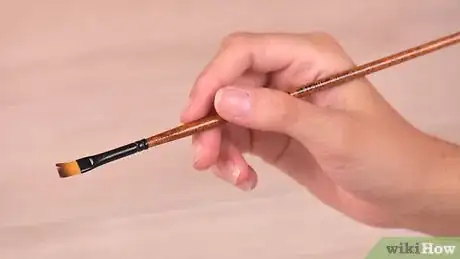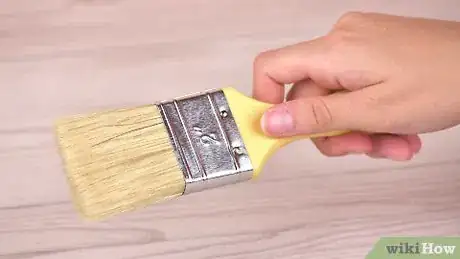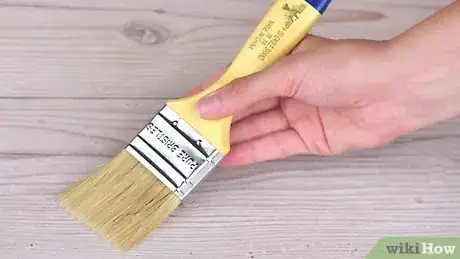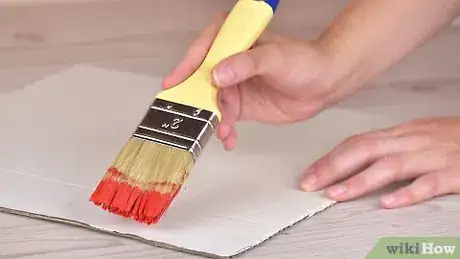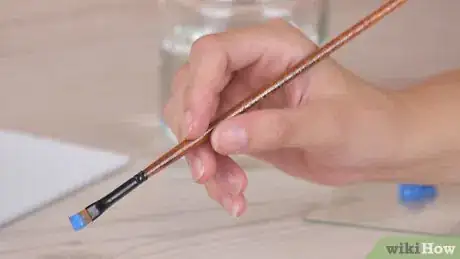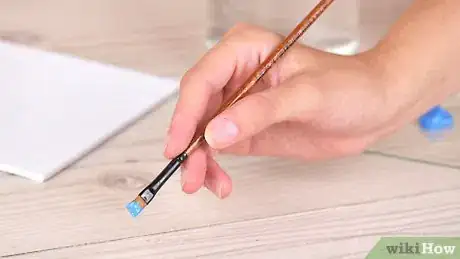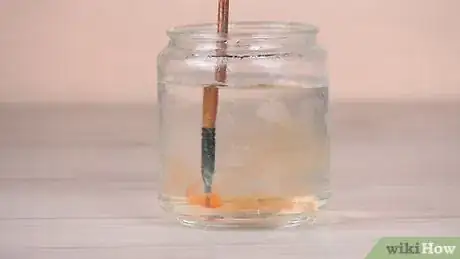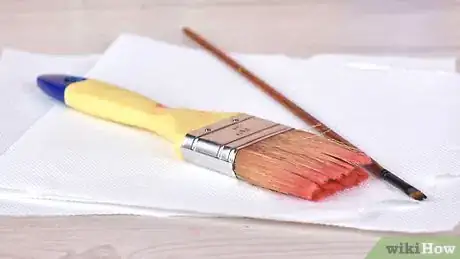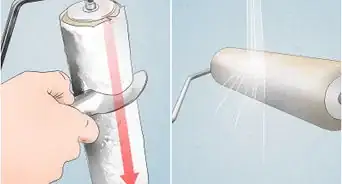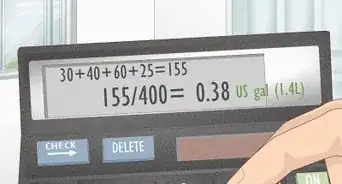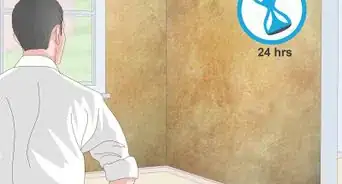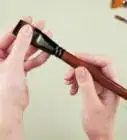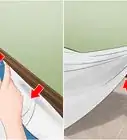This article was co-authored by Jeanine Hattas Wilson and by wikiHow staff writer, Eric McClure. Jeanine Hattas Wilson is a Professional Painter and the President of Hattas Public Murals, Inc. With nearly 20 years of experience, Jeanine specializes in creating, overseeing, designing, and painting murals. Jeanine holds a BA in Advertising from Marquette University and a Studio Painting Minor from The Milwaukee Institute of Art & Design. She has studied at The Atelier Artien in Paris, France, Los Angeles Academy of Figurative Art, and under renowned artists such as Robert Liberace, Michael Siegel, and William Cochran. To date, Hattas Public Murals has painted nearly 5,000 commissioned works of art in homes and commercial and public spaces.
There are 14 references cited in this article, which can be found at the bottom of the page.
This article has been viewed 241,327 times.
The key to a good paint job is to use high quality paint and a good paint brush. Buy the best brush you can afford and make sure it's the right kind for the type of paint you're using. Latex brushes don't work well with oil paints, nor do oil brushes work with water-based paints.[1] Once you have the right brush, you can focus on technique!
Steps
Loading a Paintbrush
-
1Choose an artist’s brush if you’re making art or adding details. If you’re making art, pick up a set of artist’s brushes in a variety of sizes and shapes. Each style of brush is unique and creates a different type of line. The brushes you choose for a particular painting are entirely up to you, but it helps to have options. You can also use an artist’s brush to paint small surfaces or add fill in details on a wall if you’re repainting your home or creating a mural.[2]
- You also have a choice between synthetic and natural brushes. Generally speaking, natural bristles are best for oil paint, while synthetic is best for acrylic and watercolor paint.
Types of Artist’s Brushes:
Round brushes are the most common artist’s brush. They have a round tip that make them easy to apply a variety of lines in different textures.
Flat brushes are the second most popular brush. You can hold them with the broad side flat to add a thick line, or turn them on their side for a thinner line.
Filbert brushes have a rounded tip that sticks out in the center. You can use them to make strokes of different sizes by holding the bristles against the surface at unique angles.
Fan brushes have bristles that flare out to the sides. They’re ideal for adding unique textures and details.
Rigger brushes are really long and thin. They’re ideal for making small, delicate strokes, especially if you’re trying to achieve straight lines that don’t bleed.
-
2Use a painter’s brush if you’re painting interior walls or large surfaces. Painter’s brushes refer to the paintbrushes are typically used by interior painters. They’re usually 1–4 inches (2.5–10.2 cm) wide and they usually have a unique hourglass-shaped handle. If you’re repainting your home or business, grab a painter’s brush. Artists often use painter brushes to repaint canvases, apply primer, or add large sections of color.[3]
- Use a natural brush for oil-based paints and primers. Use a synthetic brush for latex paints. Synthetic painter’s brushes are almost always made out of nylon.
Types of Painter’s Brushes:
Square cut brushes are perfectly flat on the end. They’re really only used to paint flat surfaces.
Angle brushes have bristles that rest at a 30- to 45-degree angle and make painting trim and corners much easier. These are the main brushes used by professional painters since you can just hold them at an angle to turn them into flat brushes.
Round brushes have rounded bristles. These are basically only used for details or mural painting.
Advertisement -
3Dampen the brush with water or mineral spirits to prepare it. If you’re using acrylic, latex, or watercolor paint, dip your brush’s bristles in water. If you’re using an oil paint, dip the bristles in mineral spirits. This will make the paint stick to your bristles for longer and reduce how often you need to reload the brush. It will also make cleaning the brush easier.[4]
- Blot the bristles with a dry cloth after you dip them to keep them from dripping with water or mineral spirits. You don’t want them to be soaked, just a little damp.
- Artist and painter brushes are loaded the same way. There’s no real difference between them when it comes to loading them with paint.
-
4Lower the bristles half way into the paint to load them up. Pour your paint in a paint tray or squirt your colors out on your easel. To load your paintbrush, dip the bristles halfway into the paint. You only use the front half of the bristles to apply paint, so all you’re doing is making the bristles harder to clean if you load them up all the way.[5]
- Remember to mix the paint before using it if you’re using an interior paint that comes in a can or large bucket. The pigments tend to separate in these paints while they’re sitting on the shelf.
-
5Use the easel or paint tray to knock the excess paint off. Take the bristles out of the paint. Then, if you’re using a paint tray or can, drag the bristles against the rim on each side of the brush to knock off some of the paint. If you’re using an easel, drag the bristles back and forth next to your dollop of paint. This will remove the excess paint and keep your brush from dripping as you paint.[6]
- If you don’t do this, your brush may drip while you’re moving it. Your first brush stroke will also be saturated in paint and it won’t match the rest of the brush stroke.
Working with a Painter’s Brush
-
1Brace the sides of the brush if you’re covering a large, flat surface. If you’re painting a flat surface and there are no edges or corners nearby, hold the brush by the ferrule, which is the metal collar under the bristles. Put your thumb on one side and brace the other side with your four fingers. This grip is great because you won’t get sore quickly.[7]
- You have to apply a fair bit of pressure to cover a large surface area in paint. If you hold the brush by the handle, your wrist will get sore pretty quickly.
-
2Grip angle brushes by the junction of the ferrule for cuts and edges. For more precise cuts where the angle of the bristles matters a great deal, lay your thumb on the side right above the edge of the ferrule. Then, slide your index finger on top of the handle like you’re holding a pencil. Grip the sides of the brush with your 3 free fingers to balance it.[8]
- In painting, a “cut” refers to a straight line where 2 colors meet. When you paint the edges of a wall around the trim, it is called “cutting in.”
-
3Line the brush’s bristles up with the surface you’re painting. If you’re using a flat brush, press the bristles straight against the surface. If you’re using an angle brush, tilt the brush so the bristles line up with the surface. You can turn angle brushes so the angle is skinny and leave a thick bead of paint, or hold it vertically to spread a wider line of paint.[9]
- If the bristles aren’t flat against the surface of the wall, your line won’t be even. Part of it will look too thin and part of the line will look too rich and thick.
-
4Press the bristles against the surface and drag your arm to apply paint. Apply a light amount of pressure to the surface with your bristles. Then, keep your wrist steady and move your entire arm along the line you’re painting to apply the paint.[10]
- It’s actually pretty hard to get a straight line if you only move your wrist. Moving your entire arm ensures that your brush doesn’t shake as you move it.
-
5Drag the bristles at a 45-degree angle to the surface you’re painting. While you’re moving your arm, soften your grip up a little bit and let the bristles drag behind your wrist while you paint. If you only use the tip of the bristles, you’ll need to reload your brush every 2-3 seconds. By letting the brush drag at an angle, a larger percentage of the bristles will brush against the surface.[11]
-
6Cover each section you paint 2-3 times to smooth out the texture. Once you reach the end of a line, move the brush back in the opposite direction. This will apply another layer of paint from the other side of the bristles and fill in any small areas you missed the first time you painted the line. Reload your brush and continue painting.[12]
Tip: Depending on the texture of the wall you’re painting, you may need to cover a section 3-5 times to fill in any small specks you miss with your bristles.
Creating Art with an Artist’s Brush
-
1Use a pencil grip to hold a standard brush for precise strokes. The best way to hold an artist’s brush is to grip it on one side with your thumb and the other side with your index finger. Curl your three remaining fingers underneath the brush to brace it and keep it balanced.[13]
- This is the most common grip, but it’s fine if you find another grip that’s more comfortable for you. There is no right or wrong way to hold a brush if you’re making art!
- Some artists prefer to hold the end of the brush and lay their index finger on top to control the brush.
-
2Clutch the brush 1–3 inches (2.5–7.6 cm) behind the ferrule to balance it. Unlike a pencil, you do not hold an artist’s brush behind the bristles. Instead, slide your fingers 1–3 inches (2.5–7.6 cm) away from the metal part of the brush, called the ferrule. It’s hard to see what you’re doing if your hand is on the ferrule and you’re more likely to brush the wet paint with the side of your palm if you hold it near the tip.[14]
- It’s much easier to balance the brush in your hand and control it if you hold it near the center of gravity in the middle of the brush. The reason you can’t do this with a pencil or pen is because you need to apply pressure when you use a writing tool. You don’t really need to do that with a brush, though!
-
3Drag your wrist slowly to apply paint in straight lines. Press the tip of the bristles into the surface you’re painting and keep your wrist as steady as possible. Move your entire arm at the same time to paint a straight line. Keep the bristles at the same distance to the surface you’re painting to avoid changing the thickness of the line.[15]
- You can totally change the distance of the bristles if you want to intentionally change the thickness of the line mid-stroke!
-
4Flick the bristles with your wrist to add textures or details. For smaller flourishes of color or minor highlights, hold the bristles against the surface and move your wrist in the direction you’re adding the paint to add a quick dash of color that doesn’t look like a thick, full line. Do this over and over again to build up textures or add color.[16]
- This is the best way to build up clouds, grass, tree trunks, or textured backgrounds.
-
5Touch the canvas or paper with the very tip of the brush for minor additions. If you ever want to add a small dot or line, only touch the surface with the very tip of your bristles. You can either flick your wrist or move your arm to apply the line. This takes some practice to get the thickness of your marks right, but you’ll improve the more you paint.[17]
Tip: It’s the small details and brushstrokes that separate the good painters from the great ones! If you can master the really tiny motions with the tip of the brush, you’ll have a much easier time creating detailed and realistic images.
-
6Build your composition up with a variety of strokes to add depth. Use a variety of different strokes and movements to develop your work. Painters rarely rely on a single type of brush stroke, so mix it up and find a pattern that works for you. Alternate between different brush sizes and shapes to develop a full repertoire that makes your paintings pop.[18]
Caring for Paintbrushes
-
1Clean off your paintbrush immediately after each use. If you don’t clean your brush immediately after using it, the paint will dry on the bristles and you’ll end up with a stiff, unusable brush. While it’s fine to keep it wet for 5-10 minutes while you clean up, you really don’t want to wait too long to clean your brushes.[19]
- The one exception here is if you used oil-based primer. This stuff is extremely hard to clean and you’re better off using a cheap disposable brush if you’re working with oil-based primer.
-
2Use mineral spirits or turpentine to remove oil-based paint. If you were using oil paint, fill a small plastic cup with mineral spirits or turpentine. Submerge the bristles and shake the brush around in the liquid to remove the larger chunks of paint. Do this for 2-3 minutes.[20]
- Oil paint is typically harder to remove than acrylic or latex paint. You may need to do this 2-3 times to really get your brush clean.
-
3Pour soap and hot water on the bristles get rid of acrylic or latex paint. If you were using latex, acrylic, or watercolor paint, run your brush under warm water. Squirt 1-2 dollops of dish soap on the bristles and gently spread the soap out by hand. Run the bristles against the edge of your sink like you’re painting it while letting the water run to get rid of most of the paint.[21]
- Don’t worry about staining your sink. Latex, acrylic, and watercolor are all water-based paints and will wash off so long as you don’t let the paint dry.
-
4Shake or spin your brush while rinsing it until the water runs clear. Whether you were using mineral spirits, turpentine, or soap, take your brush and hold it under warm water. Press the bristles flat at an angle to wash each side of the bristles. Flip the bristles up and let the water pour into them directly. Once the water starts running clear, shake or spin the brush between your palms to shake out the excess moisture.[22]
Warning: Do not push the bristles down at a perpendicular angle. If you do, you may permanently damage the shape of the bristles.
-
5Let your brush air dry on a cloth or newspaper. Lay the brush flat on a clean cloth or stack of newspaper and let it air out for 2-3 hours. Once the brush is completely dry, put it back wherever you’re storing it to put it back in your brush rotation.[23]
Community Q&A
-
QuestionHow can I find a good brush?
 Community AnswerGood brushes are made with natural, not synthetic, hair. Look for brushes with wooden handles and hair that is pressed together with a metal strip. Pull gently on the hair. If any come loose, look for another brush. Otherwise, the hair will fall onto the painted surface once you are using it.
Community AnswerGood brushes are made with natural, not synthetic, hair. Look for brushes with wooden handles and hair that is pressed together with a metal strip. Pull gently on the hair. If any come loose, look for another brush. Otherwise, the hair will fall onto the painted surface once you are using it. -
QuestionWhat type of paint brush would I use when using oil-based paint?
 C GraceCommunity AnswerCheck the label while you are in the store; it will tell you whether the brush is meant for oil or water-based paint. Oil-based paint works better with natural rather than synthetic bristles.
C GraceCommunity AnswerCheck the label while you are in the store; it will tell you whether the brush is meant for oil or water-based paint. Oil-based paint works better with natural rather than synthetic bristles. -
QuestionIs it ok to wet the brush before use?
 Community AnswerYes, but it depends on what you want. If you want your paint to be thick on your canvas, use a very small amount of water on the brush or none at all. If you want the paint to be thin and easier to spread along the surface of your canvas, add water to your brush but wipe some off on the edge of your water container so the brush isn't dripping wet.
Community AnswerYes, but it depends on what you want. If you want your paint to be thick on your canvas, use a very small amount of water on the brush or none at all. If you want the paint to be thin and easier to spread along the surface of your canvas, add water to your brush but wipe some off on the edge of your water container so the brush isn't dripping wet.
Warnings
- When you clean your brushes, do not push the bristles hard into the sink you’re using to clean it. This may damage the shape of the bristles permanently.⧼thumbs_response⧽
- If you don’t clean your brushes after using them, the paint will harden and you may have to throw your brush out. You can try restoring the brush by soaking it in fabric softener or paint thinner, but this won’t always work.[25]⧼thumbs_response⧽
Things You’ll Need
- Water
- Paint tray
- Easel
- Soap
- Water
- Mineral spirits
- Turpentine (optional)
References
- ↑ https://www.sherwin-williams.com/homeowners/sw-article-dir-intchoosebrush
- ↑ https://www.artsy.net/article/artsy-editorial-10-types-paintbrushes-artist
- ↑ https://www.bobvila.com/articles/best-paint-brushes/
- ↑ https://www.thisoldhouse.com/painting/21017279/how-to-use-a-paint-brush
- ↑ https://www.thisoldhouse.com/painting/21017279/how-to-use-a-paint-brush
- ↑ https://www.thisoldhouse.com/painting/21017279/how-to-use-a-paint-brush
- ↑ https://youtu.be/O7wc_PjBr1I?t=13
- ↑ https://youtu.be/O7wc_PjBr1I?t=5
- ↑ https://youtu.be/6noW8bBBh6I?t=175
- ↑ https://www.thisoldhouse.com/painting/21017279/how-to-use-a-paint-brush
- ↑ https://youtu.be/6noW8bBBh6I?t=194
- ↑ https://youtu.be/6noW8bBBh6I?t=331
- ↑ https://youtu.be/O7wc_PjBr1I?t=31
- ↑ https://youtu.be/HG6wj57v0ig?t=37
- ↑ https://www.thisoldhouse.com/painting/21017279/how-to-use-a-paint-brush
- ↑ http://headforart.com/2017/02/24/brushstrokes-and-texture/
- ↑ http://headforart.com/2017/02/24/brushstrokes-and-texture/
- ↑ http://headforart.com/2017/02/24/brushstrokes-and-texture/
- ↑ https://www.bobvila.com/articles/2156-how-to-clean-paint-brushes/
- ↑ https://www.bobvila.com/articles/2156-how-to-clean-paint-brushes/
- ↑ https://www.bobvila.com/articles/2156-how-to-clean-paint-brushes/
- ↑ https://www.bobvila.com/articles/2156-how-to-clean-paint-brushes/
- ↑ https://www.bobvila.com/articles/2156-how-to-clean-paint-brushes/
- ↑ https://www.thisoldhouse.com/painting/21017279/how-to-use-a-paint-brush
- ↑ https://www.apartmenttherapy.com/how-to-clean-old-paintbrushes-199735
